2000 TOYOTA CAMRY Fuse a
[x] Cancel search: Fuse aPage 1294 of 4770
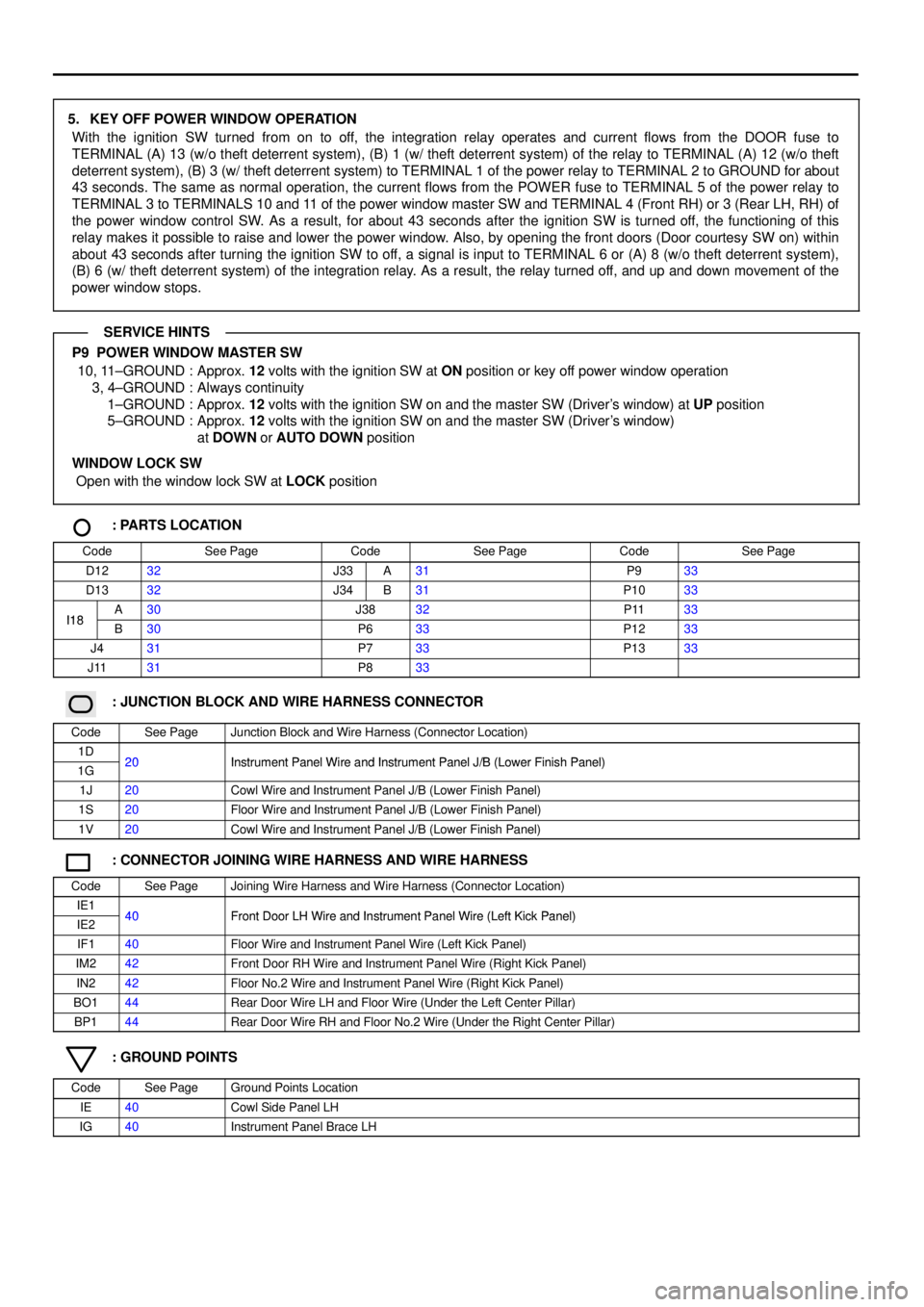
5. KEY OFF POWER WINDOW OPERATION
With the ignition SW turned from on to off, the integration relay operates and current flows from the DOOR fuse to
TERMINAL (A) 13 (w/o theft deterrent system), (B) 1 (w/ theft deterrent system) of the relay to TERMINAL (A) 12 (w/o theft
deterrent system), (B) 3 (w/ theft deterrent system) to TERMINAL 1 of the power relay to TERMINAL 2 to GROUND for about
43 seconds. The same as normal operation, the current flows from the POWER fuse to TERMINAL 5 of the power relay to
TERMINAL 3 to TERMINALS 10 and 11 of the power window master SW and TERMINAL 4 (Front RH) or 3 (Rear LH, RH) of
the power window control SW. As a result, for about 43 seconds after the ignition SW is turned off, the functioning of this
relay makes it possible to raise and lower the power window. Also, by opening the front doors (Door courtesy SW on) within
about 43 seconds after turning the ignition SW to off, a signal is input to TERMINAL 6 or (A) 8 (w/o theft deterrent system),
(B) 6 (w/ theft deterrent system) of the integration relay. As a result, the relay turned off, and up and down movement of the
power window stops.
P9 POWER WINDOW MASTER SW
10, 11±GROUND : Approx. 12 volts with the ignition SW at ON position or key off power window operation
3, 4±GROUND : Always continuity
1±GROUND : Approx. 12 volts with the ignition SW on and the master SW (Driver's window) at UP position
5±GROUND : Approx. 12 volts with the ignition SW on and the master SW (Driver's window)
at DOWN or AUTO DOWN position
WINDOW LOCK SW
Open with the window lock SW at LOCK position
: PARTS LOCATION
CodeSee PageCodeSee PageCodeSee Page
D1232J33A31P933
D1332J34B31P1033
I18A30J3832P1133I18B30P633P1233
J431P733P1333
J1131P833
: JUNCTION BLOCK AND WIRE HARNESS CONNECTOR
CodeSee PageJunction Block and Wire Harness (Connector Location)
1D20Instrument Panel Wire and Instrument Panel J/B (Lower Finish Panel)1G20Instrument Panel Wire and Instrument Panel J/B (Lower Finish Panel)
1J20Cowl Wire and Instrument Panel J/B (Lower Finish Panel)
1S20Floor Wire and Instrument Panel J/B (Lower Finish Panel)
1V20Cowl Wire and Instrument Panel J/B (Lower Finish Panel)
: CONNECTOR JOINING WIRE HARNESS AND WIRE HARNESS
CodeSee PageJoining Wire Harness and Wire Harness (Connector Location)
IE140Front Door LH Wire and Instrument Panel Wire (Left Kick Panel)IE240Front Door LH Wire and Instrument Panel Wire (Left Kick Panel)
IF140Floor Wire and Instrument Panel Wire (Left Kick Panel)
IM242Front Door RH Wire and Instrument Panel Wire (Right Kick Panel)
IN242Floor No.2 Wire and Instrument Panel Wire (Right Kick Panel)
BO144Rear Door Wire LH and Floor Wire (Under the Left Center Pillar)
BP144Rear Door Wire RH and Floor No.2 Wire (Under the Right Center Pillar)
: GROUND POINTS
CodeSee PageGround Points Location
IE40Cowl Side Panel LH
IG40Instrument Panel Brace LH
SERVICE HINTS
Page 1299 of 4770

DOOR LOCK CONTROL (TMC MADE)
Current always flows to TERMINAL (A) 13 (w/o theft deterrent system), (B) 1 (w/ theft deterrent system) of the integration
relay through the DOOR fuse.
When the ignition SW is turned on, the current flowing through the GAUGE Fuse flows to TERMINAL 7 of the integration
relay to TERMINAL (A) 12 (w/o theft deterrent system), (B) 3 (w/ theft deterrent system) to the power relay (Coil side) to
GROUND.
1. MANUAL LOCK OPERATION
When the door lock control SW or door key lock and unlock SW are operated to LOCK position, a lock signal is input to
TERMINAL (A) 1 or (A) 3 (w/o theft deterrent system), (B) 16 or (B) 18 (w/ theft deterrent system) of the integration relay and
causes the relay to function. Current flows from TERMINAL (A) 13 (w/o theft deterrent system), (B) 1 (w/ theft deterrent
system) of the relay to (A) 6 (w/o theft deterrent system), (B) 12 (w/ theft deterrent system) to TERMINAL 2 of the door lock
motors to TERMINAL 3 to TERMINAL (A) 7 (w/o theft deterrent system), (B) 11 and (B) 25 (w/ theft deterrent system) of the
relay to TERMINAL 10 to GROUND and the door lock motor causes the door to lock.
2. MANUAL UNLOCK OPERATION
When the door lock control SW or door key lock and unlock SW are operated to UNLOCK position, an unlock signal is input
to TERMINAL (A) 2, (A) 4 or (A) 5 (w/o theft deterrent system), (B) 17, (B) 19 or (B) 20 (w/ theft deterrent system) of the
integration relay and causes the relay to function. Current flows from TERMINAL (A) 13 (w/o theft deterrent system), (B) 1 (w/
theft deterrent system) of the relay to TERMINAL (A) 7 (w/o theft deterrent system), (B) 11 and (B) 25 (w/ theft deterrent
system) to TERMINAL 3 of the door lock motors to TERMINAL 2 to TERMINAL (A) 6 (w/o theft Deterrent system), (B) 12 (w/
theft deterrent system) of the relay to TERMINAL 10 to GROUND and door lock motors causes door to unlock.
3. DOUBLE OPERATION UNLOCK OPERATION
When the door key lock and unlock SW front LH is turned to the unlock side, only the driver's door is mechanically unlocked.
Turning the door key lock and unlock SW front LH to the unlock side causes a signal to be input to TERMINAL (A) 4 (w/o
theft deterrent system), (B) 19 (w/ theft deterrent system) of the relay, and if the signal is input again within 3 seconds by
turning the SW to the unlock side again, current flows from TERMINAL (A) 7 (w/o theft deterrent system), (B) 11 and (B) 25
(w/ theft deterrent system) of the integration relay to TERMINAL 3 of the door lock motors to TERMINAL 2 of the door lock
motors to TERMINAL (A) 6 (w/o theft deterrent system), (B) 12 (w/ theft deterrent system) of the relay to TERMINAL 10 to
GROUND, causing the door lock motors to operate and unlock the doors.
4. IGNITION KEY REMINDER OPERATION
*Operating door lock knob (Operation of door lock motors)
With ignition key in cylinder (Unlock warning SW on), when the door is opened and locked using door lock knob (Door
lock motor), the door is locked once but each door is unlocked soon by the function of the relay. As a result, the current
flows from TERMINAL (A) 13 (w/o theft deterrent system), (B) 1 (w/ theft deterrent system) of the integration relay to
TERMINAL (A) 7 (w/o theft deterrent system),(B) 11 and (B) 25 (w/ theft deterrent system) to TERMINAL 3 of the door
lock motors to TERMINAL 2 of the door lock motors to TERMINAL (A) 6 (w/o theft deterrent system), (B) 12 (w/ theft
deterrent system) of the relay to TERMINAL 10 to GROUND and causes all the doors to unlock.
*Operating door lock control SW or door key lock and unlock SW
With ignition key in cylinder (Unlock warning SW on), when the door is opened and locked using door lock control SW or
key SW, the door is locked once but each door is unlock by the function of SW contained in motors, which the signal is
input to TERMINAL (A) 9 or (A) 10 (w/o theft deterrent system), (B) 5 or (B) 7 (w/ theft deterrent system) of the relay.
According to this input signal, the current in ECU flows from TERMINAL (A) 13 (w/o theft deterrent system), (B) 1 (w/
theft deterrent system) of the relay to TERMINAL (A) 7 (w/o theft deterrent system), (B) 11 and (B) 25 (w/ theft deterrent
system) to TERMINAL 3 of the door lock motors to TERMINAL 2 of the door lock motors to TERMINAL (A) 6 (w/o theft
deterrent system), (B) 12 (w/ theft deterrent system) of the relay to TERMINAL 10 to GROUND and causes all the doors
to unlock.
*In case of key less lock
With ignition key in cylinder (Unlock warning SW on), when the unlock function is disturbed more than 0.2 seconds, for
example pushing the door lock knob etc., the door holds on lock condition. Closing the door after, door courtesy SW
inputs the signal into TERMINAL 6 or (A) 8 (w/o theft deterrent system), (B) 6 (w/ theft deterrent system) of the
integration relay. By this input signal, the ECU works and current flows from TERMINAL (A) 13 (w/o theft deterrent
system), (B) 1 (w/ theft deterrent system) of the relay to TERMINAL (A) 7 (w/o theft deterrent system), (B) 11 and (B) 25
(w/ theft deterrent system) to TERMINAL 3 of the door lock motors to TERMINAL 2 of the door lock motors to
TERMINAL (A) 6 (w/o theft deterrent system), (B) 12 (w/ theft deterrent system) of the relay to TERMINAL 10 to
GROUND and causes all the doors to unlock.
SYSTEM OUTLINE
Page 1305 of 4770

DOOR LOCK CONTROL (TMMK MADE)
Current always flows to TERMINAL (A) 13 (w/o theft deterrent system), (B) 1 (w/ theft deterrent system) of the integration
relay through the DOOR fuse.
When the ignition SW is turned on, the current flowing through the GAUGE Fuse flows to TERMINAL 7 of the integration
relay to TERMINAL (A) 12 (w/o theft deterrent system), (B) 3 (w/ theft deterrent system) to the power relay (Coil side) to
GROUND
.
1. MANUAL LOCK OPERATION
When the door lock control SW or door key lock and unlock SW are operated to LOCK position, a lock signal is input to
TERMINAL (A) 1 or (A) 3 (w/o theft deterrent system), (B) 16 or (B) 18 (w/ theft deterrent system) of the integration relay and
causes the relay to function. Current flows from TERMINAL (A) 13 (w/o theft deterrent system), (B) 1 (w/ theft deterrent
system) of the relay to (A) 6 (w/o theft deterrent system), (B) 12 (w/ theft deterrent system) to TERMINAL 2 of the door lock
motors to TERMINAL 3 to TERMINAL (A) 7 (w/o theft deterrent system), (B) 11
and (B) 25 (w/ theft deterrent system) of the
relay to TERMINAL 10 to GROUND and the door lock motor causes the door to lock.
2. MANUAL UNLOCK OPERATION
When the door lock control SW or door key lock and unlock SW are operated to UNLOCK position, an unlock signal is input
to TERMINAL (A) 2, (A) 4 or (A) 5 (w/o theft deterrent system), (B) 17, (B) 19 or (B) 20 (w/ theft deterrent system) of the
integration relay and causes the relay to function. Current flows from TERMINAL (A) 13 (w/o theft deterrent system),
(B) 1
(w/ theft deterrent system) of the relay to TERMINAL (A) 7 (w/o theft deterrent system), (B) 11 and (B) 25 (w/ theft deterrent
system) to TERMINAL 3 of the door lock motors to TERMINAL 2 to TERMINAL (A) 6 (w/o theft Deterrent system), (B) 12 (w/
theft deterrent system) of the relay to TERMINAL 10 to GROUND and door lock motors causes door to unlock.
3. DOUBLE OPERATION UNLOCK OPERATION
When the door key lock and unlock SW front LH is turned to the unlock side, only the driver's door is mechanically unlocked.
Turning the door key lock and unlock SW front LH to the unlock side causes a signal to be input to TERMINAL (A) 4 (w/o
theft deterrent system), (B) 19 (w/ theft deterrent system) of the relay, and if the signal is input again within 3 seconds by
turning the SW to the unlock side again, current flows from TERMINAL (A) 7 (w/o theft deterrent system),
(B) 11 and (B) 25
(w/ theft deterrent system) of the integration relay to TERMINAL 3 of the door lock motors to TERMINAL 2 of the door lock
motors to TERMINAL (A) 6 (w/o theft deterrent system), (B) 12 (w/ theft deterrent system) of the relay to TERMINAL 10 to
GROUND, causing the door lock motors to operate and unlock the doors.
4. IGNITION KEY REMINDER OPERATION
*Operating door lock knob (Operation of door lock motors)
With ignition key in cylinder (Unlock warning SW on), when the door is opened and locked using door lock knob (Door
lock motor), the door is locked once but each door is unlocked soon by the function of the relay. As a result, the current
flows from TERMINAL (A) 13 (w/o theft deterrent system), (B) 1 (w/ theft deterrent system) of the integration relay to
TERMINAL (A) 7 (w/o theft deterrent system),(B) 11 and (B) 25
(w/ theft deterrent system) to TERMINAL 3 of the door
lock motors to TERMINAL 2 of the door lock motors to TERMINAL (A) 6 (w/o theft deterrent system), (B) 12 (w/ theft
deterrent system) of the relay to TERMINAL 10 to GROUND and causes all the doors to unlock.
*Operating door lock control SW or door key lock and unlock SW
With ignition key in cylinder (Unlock warning SW on), when the door is opened and locked using door lock control SW or
key SW, the door is locked once but each door is unlock by the function of SW contained in motors, which the signal is
input to TERMINAL (A) 9 or (A) 10 (w/o theft deterrent system), (B) 5 or (B) 7 (w/ theft deterrent system) of the relay.
According to this input signal, the current in ECU flows from TERMINAL (A) 13 (w/o theft deterrent system), (B) 1 (w/
theft deterrent system) of the relay to TERMINAL (A) 7 (w/o theft deterrent system), (B) 11 and (B) 25 (w/ theft deterrent
system) to TERMINAL 3 of the door lock motors to TERMINAL 2 of the door lock motors to TERMINAL (A) 6 (w/o theft
deterrent system), (B) 12 (w/ theft deterrent system) of the relay to TERMINAL 10 to GROUND and causes all the doors
to unlock.
*In case of key less lock
With ignition key in cylinder (Unlock warning SW on), when the unlock function is disturbed more than 0.2 seconds, for
example pushing the door lock knob etc., the door holds on lock condition. Closing the door after, door courtesy SW
inputs the signal into TERMINAL 6 or (A) 8 (w/o theft deterrent system), (B) 6 (w/ theft deterrent system) of the
integration relay. By this input signal, the ECU works and current flows from
TERMINAL (A) 13 (w/o theft deterrent
system), (B) 1 (w/ theft deterrent system) of the relay to TERMINAL (A) 7 (w/o theft deterrent system), (B) 11 and (B) 25
(w/ theft deterrent system) to TERMINAL 3 of the door lock motors to TERMINAL 2 of the door lock motors to
TERMINAL (A) 6 (w/o theft deterrent system), (B) 12 (w/ theft deterrent system) of the relay to TERMINAL 10 to
GROUND and causes all the doors to unlock.
SYSTEM OUTLINE
Page 1342 of 4770
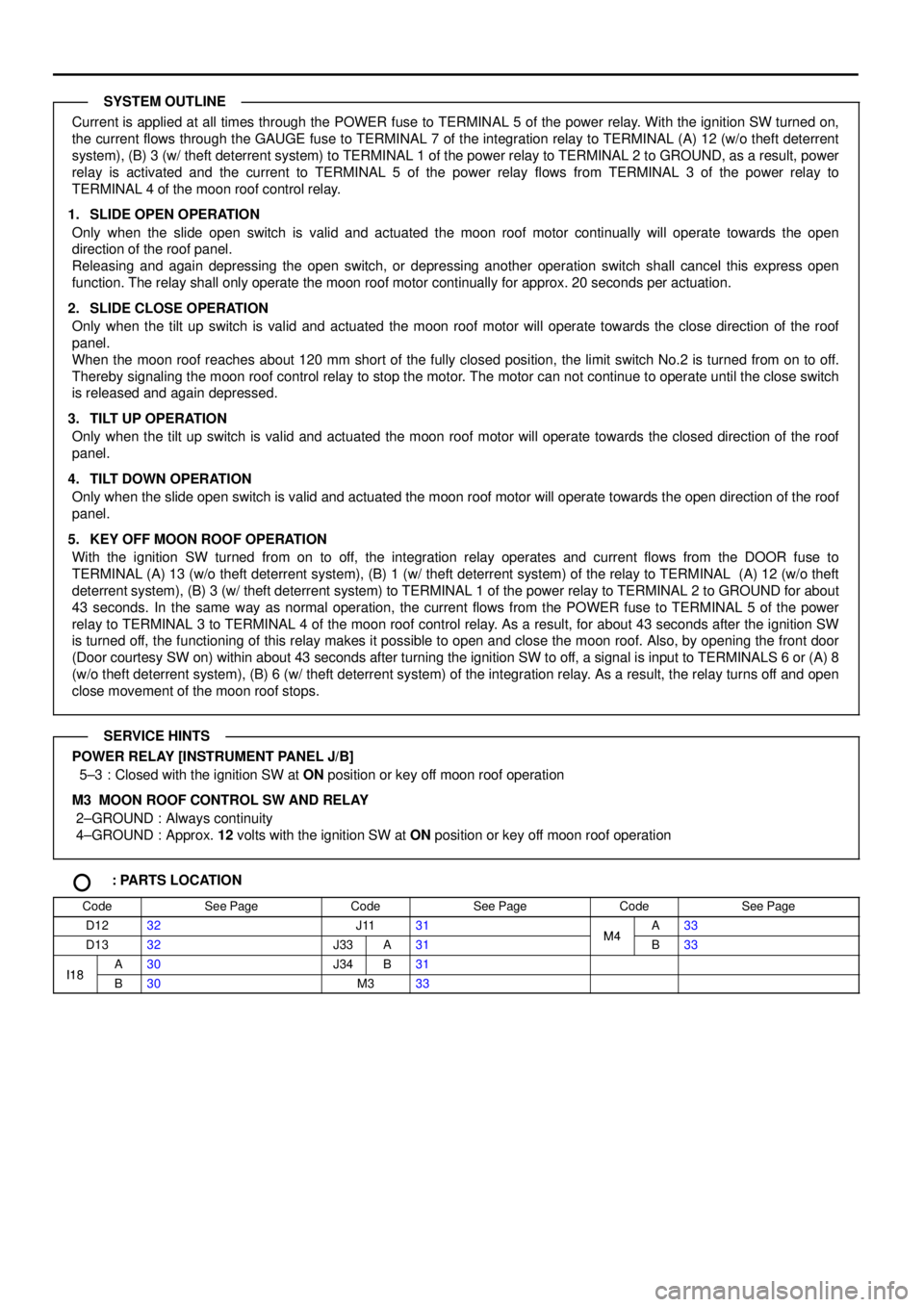
Current is applied at all times through the POWER fuse to TERMINAL 5 of the power relay. With the ignition SW turned on,
the current flows through the GAUGE fuse to TERMINAL 7 of the integration relay to TERMINAL (A) 12 (w/o theft deterrent
system), (B) 3 (w/ theft deterrent system) to TERMINAL 1 of the power relay to TERMINAL 2 to GROUND, as a result, power
relay is activated and the current to TERMINAL 5 of the power relay flows from TERMINAL 3 of the power relay to
TERMINAL 4 of the moon roof control relay.
1. SLIDE OPEN OPERATION
Only when the slide open switch is valid and actuated the moon roof motor continually will operate towards the open
direction of the roof panel.
Releasing and again depressing the open switch, or depressing another operation switch shall cancel this express open
function. The relay shall only operate the moon roof motor continually for approx. 20 seconds per actuation.
2. SLIDE CLOSE OPERATION
Only when the tilt up switch is valid and actuated the moon roof motor will operate towards the close direction of the roof
panel.
When the moon roof reaches about 120 mm short of the fully closed position, the limit switch No.2 is turned from on to off.
Thereby signaling the moon roof control relay to stop the motor. The motor can not continue to operate until the close switch
is released and again depressed.
3. TILT UP OPERATION
Only when the tilt up switch is valid and actuated the moon roof motor will operate towards the closed direction of the roof
panel.
4. TILT DOWN OPERATION
Only when the slide open switch is valid and actuated the moon roof motor will operate towards the open direction of the roof
panel.
5. KEY OFF MOON ROOF OPERATION
With the ignition SW turned from on to off, the integration relay operates and current flows from the DOOR fuse to
TERMINAL (A) 13 (w/o theft deterrent system), (B) 1 (w/ theft deterrent system) of the relay to TERMINAL (A) 12 (w/o theft
deterrent system), (B) 3 (w/ theft deterrent system) to TERMINAL 1 of the power relay to TERMINAL 2 to GROUND for about
43 seconds. In the same way as normal operation, the current flows from the POWER fuse to TERMINAL 5 of the power
relay to TERMINAL 3 to TERMINAL 4 of the moon roof control relay. As a result, for about 43 seconds after the ignition SW
is turned off, the functioning of this relay makes it possible to open and close the moon roof. Also, by opening the front door
(Door courtesy SW on) within about 43 seconds after turning the ignition SW to off, a signal is input to TERMINALS 6 or (A) 8
(w/o theft deterrent system), (B) 6 (w/ theft deterrent system) of the integration relay. As a result, the relay turns off and open
close movement of the moon roof stops.
POWER RELAY [INSTRUMENT PANEL J/B]
5±3 : Closed with the ignition SW at ON position or key off moon roof operation
M3 MOON ROOF CONTROL SW AND RELAY
2±GROUND : Always continuity
4±GROUND : Approx. 12 volts with the ignition SW at ON position or key off moon roof operation
: PARTS LOCATION
CodeSee PageCodeSee PageCodeSee Page
D1232J1131M4A33
D1332J33A31M4B33
I18A30J34B31I18B30M333
SYSTEM OUTLINE
SERVICE HINTS
Page 1367 of 4770

CRUISE CONTROL
Current is applied at all times through the STOP fuse to TERMINAL 2 of the stop light SW.
With the ignition SW turned to on, current flows through the GAUGE fuse to TERMINAL (C) 7 of the combination meter and
the current through the ECU±IG fuse flows to TERMINAL 9 of the cruise control ECU.
When the ignition SW is on and the cruise control SW is turned on, a signal is input from TERMINAL 5 of the cruise control
SW to TERMINAL 11 of the cruise control ECU. As a result, the cruise control ECU functions and the current flows from the
ECU±IG fuse to TERMINAL 9 of the cruise control ECU to TERMINAL 16 to GROUND, and the cruise control system is in a
condition ready for operation.
At the same time, the current through the GAUGE fuse flows to TERMINAL (C) 7 of the cruise control indicator light to
TERMINAL (C) 10 to TERMINAL 4 of the cruise control ECU to TERMINAL 16 to GROUND, causing the cruise control
indicator light to light up, indicating that cruise control is ready for operation.
1. SET OPERATION
When the cruise control SW is turned on and the set SW is pushed with the vehicle speed within the set limit (Approx. 40
km/h, 25 mph to 200 km/h, 124 mph), a signal is input to TERMINAL 10 of the cruise control ECU and the vehicle speed at
the time the set SW is released is memorized in the ECU as the set speed.
2. SET SPEED CONTROL
During cruise control driving, the cruise control ECU compares the set speed memorized in the cruise control ECU with the
actual vehicle speed input into TERMINAL 12 of the cruise control ECU from the speed sensor, and controls the cruise
control actuator to maintain the set speed.
When the actual speed is lower than the set speed, the ECU causes the current to the cruise control actuator to flow from
TERMINAL 15 of the cruise control ECU to TERMINAL 1 of the cruise control actuator to TERMINAL 2 to TERMINAL 7 of
the cruise control ECU. As a result, the motor in the cruise control actuator is rotated to open the than the set speed, the
current to the cruise control actuator flows from TERMINAL 7 of the cruise control ECU to TERMINAL 2 of the cruise control
actuator to TERMINAL 1 to TERMINAL 15 of the cruise control ECU.
This causes the motor in the cruise control actuator to rotate to close the throttle valve and return the throttle cable to
decrease the vehicle speed.
3. COAST CONTROL
During cruise control driving, while the coast SW is on, the cruise control actuator returns the throttle cable to close the
throttle valve and decrease the driving speed. The vehicle speed when the coast SW is turned off is memorized and the
vehicle continues at the new set speed.
4. ACCEL CONTROL
During cruise control driving, while the accel SW is turned on, the cruise control actuator pulls the throttle cable to open the
throttle valve and increase the driving speed.
The vehicle speed when the accel SW is turned off is memorized and the vehicle continues at the new set speed.
5. RESUME CONTROL
Unless the vehicle speed falls below the minimum speed limit (Approx. 40km/h, 25mph) after canceling the set speed by the
cancel SW, pushing the resume SW will cause the vehicle to resume the speed set before cancellation.
6. MANUAL CANCEL MECHANISM
If any of the following operations occurs during cruise control operation, the magnetic clutch of the actuator turns off and the
motor rotates to close the throttle valve and the cruise control is released.
*Placing the shift lever except D position (Park/Neutral position SW except D position). ºSignal is not input to TERMINAL 3
of the cruise control ECUº (A/T)
*Depressing the clutch pedal (Cruise control clutch SW off). ºSignal input to TERMINAL 3 of the cruise control ECUº (M/T)
*Depressing the brake pedal (Stop light SW on). ºSignal input to TERMINAL 2 of the cruise control ECUº
*Pushing the cancel switch (Cancel SW on). ºSignal input to TERMINAL 10 of the cruise control ECUº
*Pushing the cruise switch off ºsignal input to TERMINAL 11 of the cruise control ECUº.
SYSTEM OUTLINE
Page 1395 of 4770
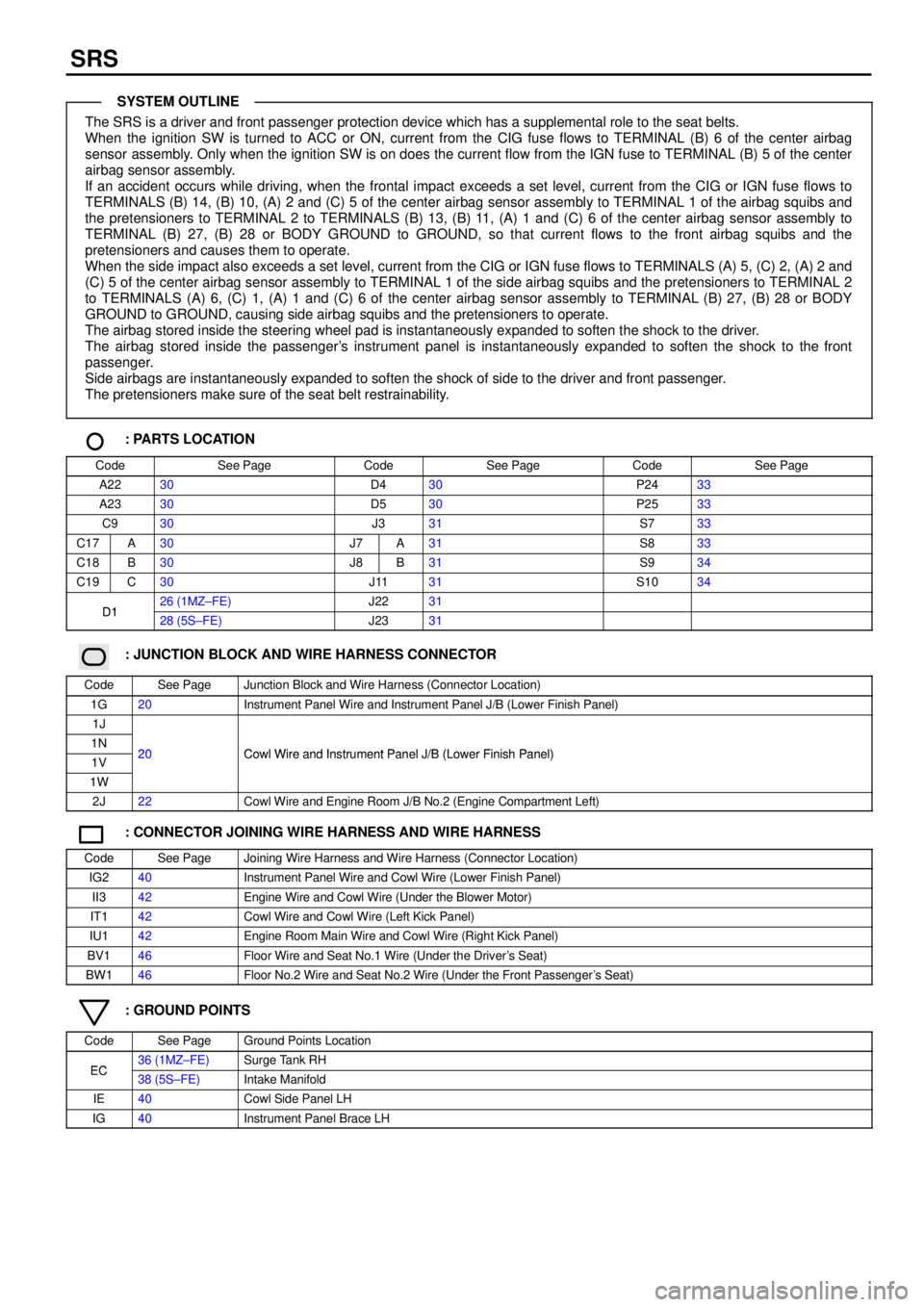
SRS
The SRS is a driver and front passenger protection device which has a supplemental role to the seat belts.
When the ignition SW is turned to ACC or ON, current from the CIG fuse flows to TERMINAL (B) 6 of the center airbag
sensor assembly. Only when the ignition SW is on does the current flow from the IGN fuse to TERMINAL (B) 5 of the center
airbag sensor assembly.
If an accident occurs while driving, when the frontal impact exceeds a set level, current from the CIG or IGN fuse flows to
TERMINALS (B) 14, (B) 10, (A) 2 and (C) 5 of the center airbag sensor assembly to TERMINAL 1 of the airbag squibs and
the pretensioners to TERMINAL 2 to TERMINALS (B) 13, (B) 11, (A) 1 and (C) 6 of the center airbag sensor assembly to
TERMINAL (B) 27, (B) 28 or BODY GROUND to GROUND, so that current flows to the front airbag squibs and the
pretensioners and causes them to operate.
When the side impact also exceeds a set level, current from the CIG or IGN fuse flows to TERMINALS (A) 5, (C) 2, (A) 2 and
(C) 5 of the center airbag sensor assembly to TERMINAL 1 of the side airbag squibs and the pretensioners to TERMINAL 2
to TERMINALS (A) 6, (C) 1, (A) 1 and (C) 6 of the center airbag sensor assembly to TERMINAL (B) 27, (B) 28 or BODY
GROUND to GROUND, causing side airbag squibs and the pretensioners to operate.
The airbag stored inside the steering wheel pad is instantaneously expanded to soften the shock to the driver.
The airbag stored inside the passenger's instrument panel is instantaneously expanded to soften the shock to the front
passenger.
Side airbags are instantaneously expanded to soften the shock of side to the driver and front passenger.
The pretensioners make sure of the seat belt restrainability.
: PARTS LOCATION
CodeSee PageCodeSee PageCodeSee Page
A2230D430P2433
A2330D530P2533
C930J331S733
C17A30J7A31S833
C18B30J8B31S934
C19C30J1131S1034
D126 (1MZ±FE)J2231D128 (5S±FE)J2331
: JUNCTION BLOCK AND WIRE HARNESS CONNECTOR
CodeSee PageJunction Block and Wire Harness (Connector Location)
1G20Instrument Panel Wire and Instrument Panel J/B (Lower Finish Panel)
1J
1N20Cowl Wire and Instrument Panel J/B (Lower Finish Panel)1V20Cowl Wire and Instrument Panel J/B (Lower Finish Panel)
1W
2J22Cowl Wire and Engine Room J/B No.2 (Engine Compartment Left)
: CONNECTOR JOINING WIRE HARNESS AND WIRE HARNESS
CodeSee PageJoining Wire Harness and Wire Harness (Connector Location)
IG240Instrument Panel Wire and Cowl Wire (Lower Finish Panel)
II342Engine Wire and Cowl Wire (Under the Blower Motor)
IT142Cowl Wire and Cowl Wire (Left Kick Panel)
IU142Engine Room Main Wire and Cowl Wire (Right Kick Panel)
BV146Floor Wire and Seat No.1 Wire (Under the Driver's Seat)
BW146Floor No.2 Wire and Seat No.2 Wire (Under the Front Passenger's Seat)
: GROUND POINTS
CodeSee PageGround Points Location
EC36 (1MZ±FE)Surge Tank RHEC38 (5S±FE)Intake Manifold
IE40Cowl Side Panel LH
IG40Instrument Panel Brace LH
SYSTEM OUTLINE
Page 1400 of 4770
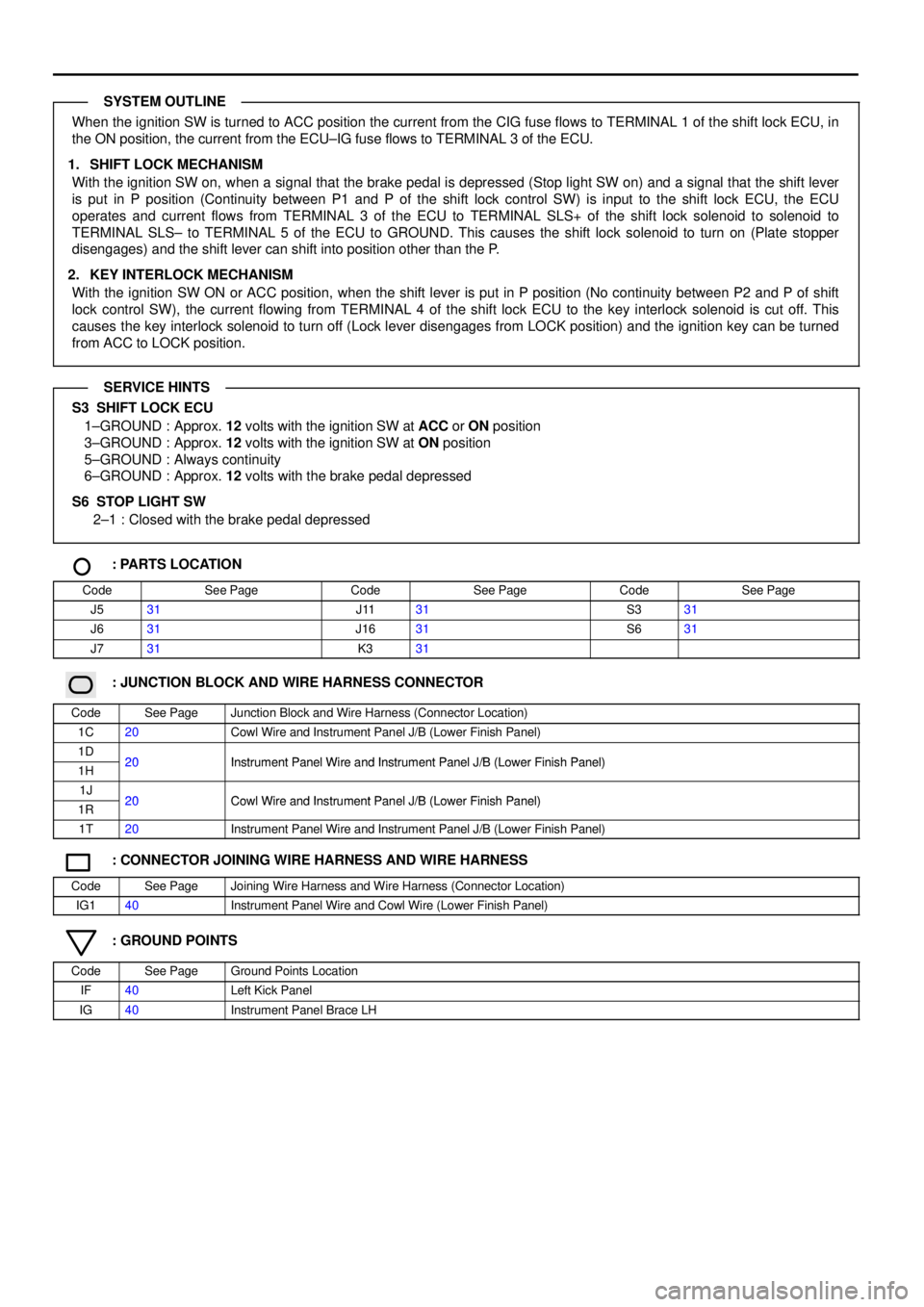
When the ignition SW is turned to ACC position the current from the CIG fuse flows to TERMINAL 1 of the shift lock ECU, in
the ON position, the current from the ECU±IG fuse flows to TERMINAL 3 of the ECU.
1. SHIFT LOCK MECHANISM
With the ignition SW on, when a signal that the brake pedal is depressed (Stop light SW on) and a signal that the shift lever
is put in P position (Continuity between P1 and P of the shift lock control SW) is input to the shift lock ECU, the ECU
operates and current flows from TERMINAL 3 of the ECU to TERMINAL SLS+ of the shift lock solenoid to solenoid to
TERMINAL SLS± to TERMINAL 5 of the ECU to GROUND. This causes the shift lock solenoid to turn on (Plate stopper
disengages) and the shift lever can shift into position other than the P.
2. KEY INTERLOCK MECHANISM
With the ignition SW ON or ACC position, when the shift lever is put in P position (No continuity between P2 and P of shift
lock control SW), the current flowing from TERMINAL 4 of the shift lock ECU to the key interlock solenoid is cut off. This
causes the key interlock solenoid to turn off (Lock lever disengages from LOCK position) and the ignition key can be turned
from ACC to LOCK position.
S3 SHIFT LOCK ECU
1±GROUND : Approx. 12 volts with the ignition SW at ACC or ON position
3±GROUND : Approx. 12 volts with the ignition SW at ON position
5±GROUND : Always continuity
6±GROUND : Approx. 12 volts with the brake pedal depressed
S6 STOP LIGHT SW
2±1 : Closed with the brake pedal depressed
: PARTS LOCATION
CodeSee PageCodeSee PageCodeSee Page
J531J1131S331
J631J1631S631
J731K331
: JUNCTION BLOCK AND WIRE HARNESS CONNECTOR
CodeSee PageJunction Block and Wire Harness (Connector Location)
1C20Cowl Wire and Instrument Panel J/B (Lower Finish Panel)
1D20Instrument Panel Wire and Instrument Panel J/B (Lower Finish Panel)1H20Instrument Panel Wire and Instrument Panel J/B (Lower Finish Panel)
1J20Cowl Wire and Instrument Panel J/B (Lower Finish Panel)1R20Cowl Wire and Instrument Panel J/B (Lower Finish Panel)
1T20Instrument Panel Wire and Instrument Panel J/B (Lower Finish Panel)
: CONNECTOR JOINING WIRE HARNESS AND WIRE HARNESS
CodeSee PageJoining Wire Harness and Wire Harness (Connector Location)
IG140Instrument Panel Wire and Cowl Wire (Lower Finish Panel)
: GROUND POINTS
CodeSee PageGround Points Location
IF40Left Kick Panel
IG40Instrument Panel Brace LH
SYSTEM OUTLINE
SERVICE HINTS
Page 1408 of 4770
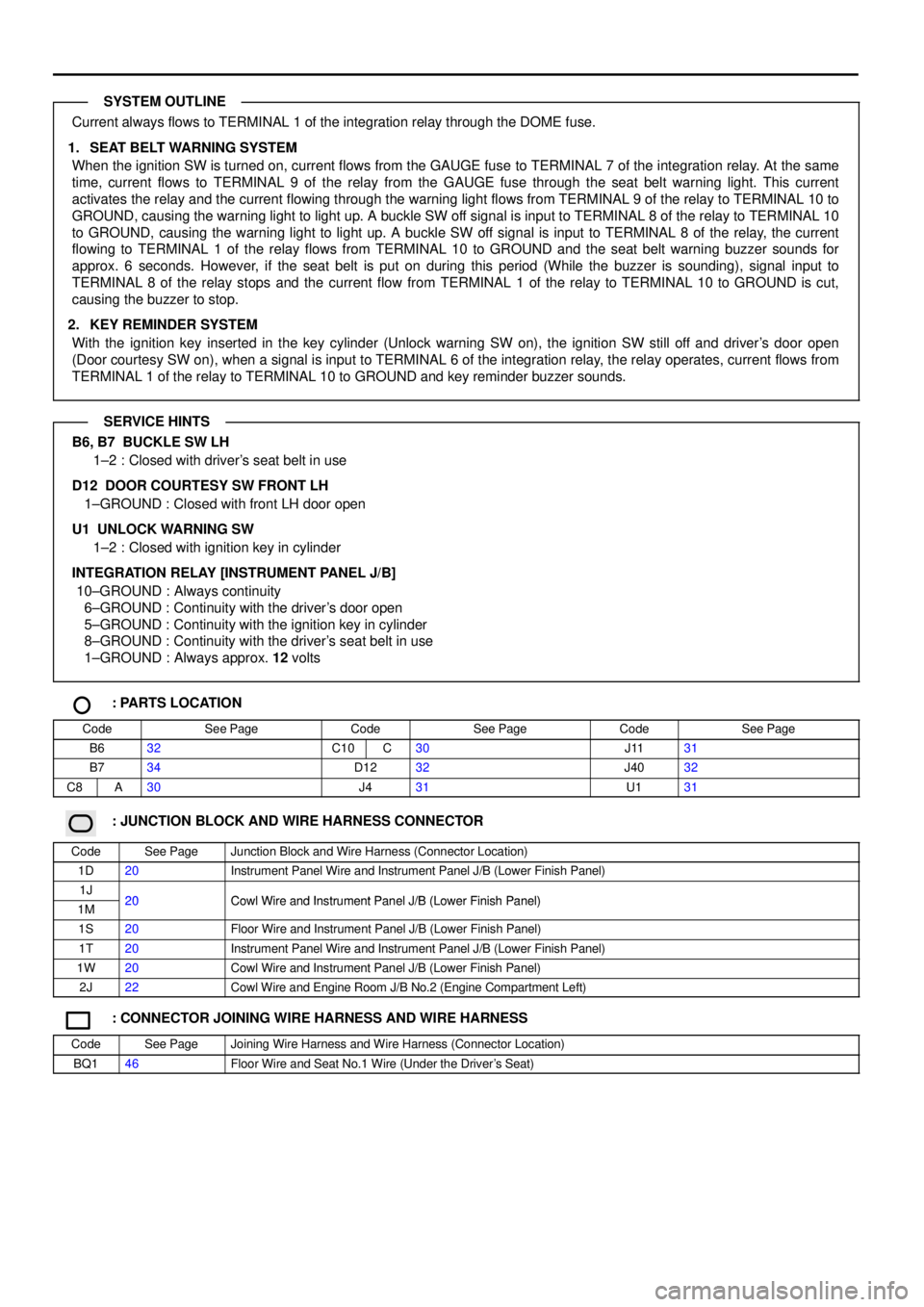
Current always flows to TERMINAL 1 of the integration relay through the DOME fuse.
1. SEAT BELT WARNING SYSTEM
When the ignition SW is turned on, current flows from the GAUGE fuse to TERMINAL 7 of the integration relay. At the same
time, current flows to TERMINAL 9 of the relay from the GAUGE fuse through the seat belt warning light. This current
activates the relay and the current flowing through the warning light flows from TERMINAL 9 of the relay to TERMINAL 10 to
GROUND, causing the warning light to light up. A buckle SW off signal is input to TERMINAL 8 of the relay to TERMINAL 10
to GROUND, causing the warning light to light up. A buckle SW off signal is input to TERMINAL 8 of the relay, the current
flowing to TERMINAL 1 of the relay flows from TERMINAL 10 to GROUND and the seat belt warning buzzer sounds for
approx. 6 seconds. However, if the seat belt is put on during this period (While the buzzer is sounding), signal input to
TERMINAL 8 of the relay stops and the current flow from TERMINAL 1 of the relay to TERMINAL 10 to GROUND is cut,
causing the buzzer to stop.
2. KEY REMINDER SYSTEM
With the ignition key inserted in the key cylinder (Unlock warning SW on), the ignition SW still off and driver's door open
(Door courtesy SW on), when a signal is input to TERMINAL 6 of the integration relay, the relay operates, current flows from
TERMINAL 1 of the relay to TERMINAL 10 to GROUND and key reminder buzzer sounds.
B6, B7 BUCKLE SW LH
1±2 : Closed with driver's seat belt in use
D12 DOOR COURTESY SW FRONT LH
1±GROUND : Closed with front LH door open
U1 UNLOCK WARNING SW
1±2 : Closed with ignition key in cylinder
INTEGRATION RELAY [INSTRUMENT PANEL J/B]
10±GROUND : Always continuity
6±GROUND : Continuity with the driver's door open
5±GROUND : Continuity with the ignition key in cylinder
8±GROUND : Continuity with the driver's seat belt in use
1±GROUND : Always approx. 12 volts
: PARTS LOCATION
CodeSee PageCodeSee PageCodeSee Page
B632C10C30J1131
B734D1232J4032
C8A30J431U131
: JUNCTION BLOCK AND WIRE HARNESS CONNECTOR
CodeSee PageJunction Block and Wire Harness (Connector Location)
1D20Instrument Panel Wire and Instrument Panel J/B (Lower Finish Panel)
1J20Cowl Wire and Instrument Panel J/B (Lower Finish Panel)1M20Cowl Wire and Instrument Panel J/B (Lower Finish Panel)
1S20Floor Wire and Instrument Panel J/B (Lower Finish Panel)
1T20Instrument Panel Wire and Instrument Panel J/B (Lower Finish Panel)
1W20Cowl Wire and Instrument Panel J/B (Lower Finish Panel)
2J22Cowl Wire and Engine Room J/B No.2 (Engine Compartment Left)
: CONNECTOR JOINING WIRE HARNESS AND WIRE HARNESS
CodeSee PageJoining Wire Harness and Wire Harness (Connector Location)
BQ146Floor Wire and Seat No.1 Wire (Under the Driver's Seat)
SYSTEM OUTLINE
SERVICE HINTS